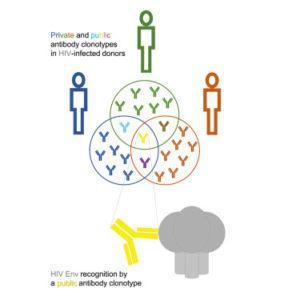HIV has caused a global health burden for the past 40 years, and currently no vaccine against the virus exists. The most successful vaccines against viral infections induce robust antibody (Ab) responses, which are the main mediators of protective immunity. This suggests that antibody responses should be one of the main targets of vaccine induced HIV immunity. Highlighting the need for improved understanding of the HIV-specific Ab repertoire.
Studies of HIV-1 specific Abs have focused on dissecting the neutralising antibody repertoire in HIV+ individuals, often focusing on antibodies that are not shared among different individuals. However, these antibody responses represent a fraction of the total HIV Ab repertoire. A collaborative research project between researchers in South Africa and US, examined the antibody repertoire in HIV infected individuals pre- and post-infection, with the aim of finding antibody clonotypes that are shared among individuals.
Researchers observed limited homogeneity in the detected Ab clonotypes from the same individual pre- and post-infection, where less than 2% of the detected Ab clonotypes were shared across follow up visits in the same individual. Interestingly, they observed multiple clonotypes that were shared among the donors studied, which they termed public clonotypes*. These public clonotypes were surprisingly observed prior to HIV infection, and the number of shared clonotypes significantly increased 3 years post natural infection. Finally, using publicly available sequencing data they were able to show that public antibody clonotypes with high sequence identity to known HIV-reactive Abs can be observed at a populations levels.
This study represents one of the first findings of public antibody clonotypes observed in HIV infected individuals that share high sequence identity with known HIV-specific antibodies. This study may have numerous implication for the understating of HIV-Ab immunity and vaccine design. Raising numerous questions such as: what is the immunological importance of public Abs? can they be targeted by future vaccine development strategies?, among other questions.
*”Public clonotypes were defined as groups of sequences with the same VH gene, the same JH gene, the same junction length, and CDRH3 amino acid sequences of high identity between donors.”
Journal Article: Setliff et al., 2018. Multi-Donor Longitudinal Antibody Repertoire Sequencing Reveals the Existence of Public Antibody Clonotypes in HIV-1 Infection. Cell Host & Microbe
Article by Cheleka AM Mpande












